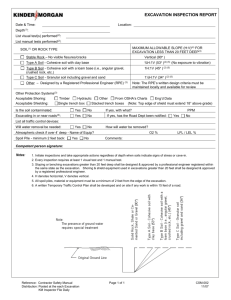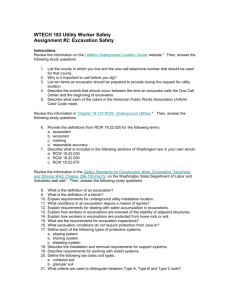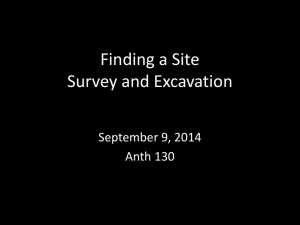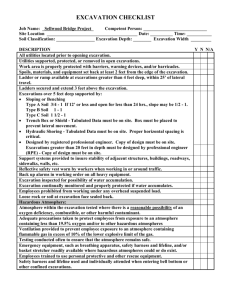Excavation-And-Trenching-Safety-Program Construction Material-Handeling Program
advertisement
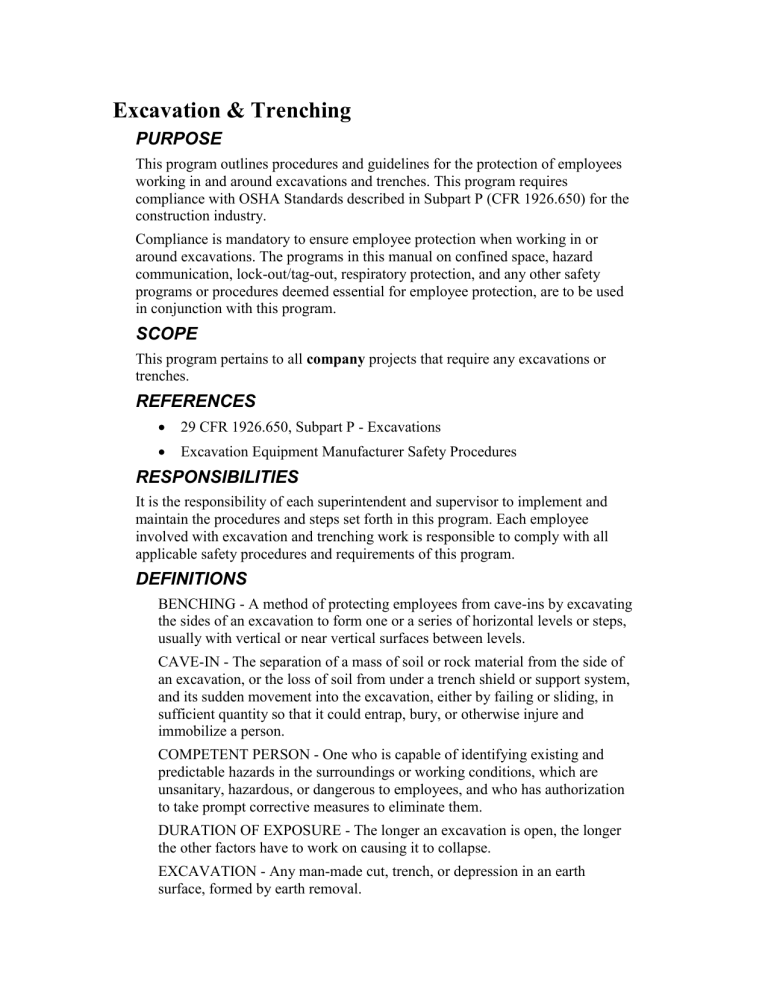
Excavation & Trenching PURPOSE This program outlines procedures and guidelines for the protection of employees working in and around excavations and trenches. This program requires compliance with OSHA Standards described in Subpart P (CFR 1926.650) for the construction industry. Compliance is mandatory to ensure employee protection when working in or around excavations. The programs in this manual on confined space, hazard communication, lock-out/tag-out, respiratory protection, and any other safety programs or procedures deemed essential for employee protection, are to be used in conjunction with this program. SCOPE This program pertains to all company projects that require any excavations or trenches. REFERENCES 29 CFR 1926.650, Subpart P - Excavations Excavation Equipment Manufacturer Safety Procedures RESPONSIBILITIES It is the responsibility of each superintendent and supervisor to implement and maintain the procedures and steps set forth in this program. Each employee involved with excavation and trenching work is responsible to comply with all applicable safety procedures and requirements of this program. DEFINITIONS BENCHING - A method of protecting employees from cave-ins by excavating the sides of an excavation to form one or a series of horizontal levels or steps, usually with vertical or near vertical surfaces between levels. CAVE-IN - The separation of a mass of soil or rock material from the side of an excavation, or the loss of soil from under a trench shield or support system, and its sudden movement into the excavation, either by failing or sliding, in sufficient quantity so that it could entrap, bury, or otherwise injure and immobilize a person. COMPETENT PERSON - One who is capable of identifying existing and predictable hazards in the surroundings or working conditions, which are unsanitary, hazardous, or dangerous to employees, and who has authorization to take prompt corrective measures to eliminate them. DURATION OF EXPOSURE - The longer an excavation is open, the longer the other factors have to work on causing it to collapse. EXCAVATION - Any man-made cut, trench, or depression in an earth surface, formed by earth removal. HAZARDOUS ATMOSPHERE - An atmosphere which by reason of being explosive, flammable, poisonous, corrosive, oxidizing, irritating, oxygen deficient, toxic, or otherwise harmful, may cause death, illness, or injury. PROTECTIVE SYSTEM - A method of protecting employees from cave-ins, from material that could fall or roll from an excavation, or from the collapse of adjacent structures. Protective systems include support systems, sloping and benching systems, shield systems, and other systems that provide necessary protection. SHIELD - A structure that is capable of withstanding the forces imposed on it by a cave-in and thereby protects employees within the structure. Shields can be permanent structures or can be designed to be portable and moved along as work progresses. All shields must be in accordance with 29 CFR 1926.652(c)3 or (c)4. SLOPING - A method of protecting workers from cave-ins by excavating to form sides of an excavation that are inclined away from the excavation to prevent cave-ins. The angle of incline required to prevent a cave-in varies with differences such as soil type, length of exposure, and application of surcharge loads. SURCHARGE LOADS - Generated by the weight of anything in proximity to the excavation, push starts for a cave-in (anything up top pushing down). Common surcharge loads: weight of spoil pile weight of nearby buildings, poles, pavement, or other structural objects. weight of material and equipment TRENCH - A narrow excavation below the surface of the ground, less than 15 feet wide, with a depth no greater than the width. UNDERMINING - Undermining can be caused by such things as leaking, leaching, caving or over-digging. Undermined walls can be very dangerous. VIBRATION - A force that is present on construction sites and must be considered. The vibrations caused by backhoes, dump trucks, compactors and traffic on job sites can be substantial. Hazards One of the reasons the company requires a competent person on-site during excavation & trenching are the numerous potential hazardous that may be encountered or created. Hazards include: Electrocution Gas Explosion Entrapment Struck by equipment Suffocation Hazard Controls Before any work is performed and before any employees enter the excavation, a number of items must be checked and insured: Before any excavation, underground installations must be determined. This can be accomplished by either contacting the local utility companies or the local "one-call' center for the area. All underground utility locations must be documented on the proper forms. All overhead hazards (surface encumbrances) that create a hazard to employees must be removed or supported to eliminate the hazard. If the excavation is to be over 20 feet deep, it must be designed by a registered professional engineer who is registered in the state where work will be performed. Adequate protective systems will be utilized to protect employees. This can be accomplished through sloping, shoring, or shielding. The worksite must be analyzed in order to design adequate protection systems and prevent cave-ins. There must also be an excavation safety plan developed to protect employees. Workers must be supplied with and wear any personal protective equipment deemed necessary to assure their protection. All spoil piles will be stored a minimum of four (4) feet from the sides of the excavation. The spoil pile must not block the safe means of egress. If a trench or excavation is 4 feet or deeper, stairways, ramps, or ladders will be used as a safe means of access and egress. For trenches, the employee must not have to travel any more than 25 feet of lateral travel to reach the stairway, ramp, or ladder. No employee will work in an excavation where water is accumulating unless adequate measures are used to protect the employees. A competent person will inspect all excavations and trenches daily, prior to employee exposure or entry, and after any rainfall, soil change, or any other time needed during the shift. The competent person must take prompt measures to eliminate any and all hazards. Excavations and trenches 4 feet or deeper that have the potential for toxic substances or hazardous atmospheres will be tested at least daily. If the atmosphere is inadequate, protective systems will be utilized. If work is in or around traffic, employees must be supplied with and wear orange reflective vests. Signs and barricades must be utilized to ensure the safety of employees, vehicular traffic, and pedestrians. COMPETENT PERSON RESPONSIBILITIES The OSHA Standards require that the competent person must be capable of identifying existing and predictable hazards in the surroundings, or working conditions which are unsanitary, hazardous, or dangerous to employees, and have authorization to take prompt corrective measures to eliminate them and, if necessary, to stop the work. A competent person is required to: Have a complete understanding of the applicable safety standards and any other data provided. Assure the proper locations of underground installations or utilities, and that the proper utility companies have been contacted. Conduct soil classification tests and reclassify soil after any condition changes. Determine adequate protective systems (sloping, shoring, or shielding systems) for employee protection. Conduct all air monitoring for potential hazardous atmospheres. Conduct daily and periodic inspections of excavations and trenches. Approve design of structural ramps, if used. EXCAVATION SAFETY PLAN An excavation safety plan is required in written form. This plan is to be developed to the level necessary to insure complete compliance with the OSHA Excavation Safety Standard and state and local safety standards. Excavation safety plan factors: Utilization of the local one-call system Determination of locations of all underground utilities Consideration of confined space atmosphere potential Proper soil protection systems and personal protective equipment and clothing Determination of soil composition and classification Determination of surface and subsurface water Depth of excavation and length of time it will remain open Proper adherence to all OSHA Standards, this excavation and trenching safety program, and any other coinciding safety programs. SOIL CLASSIFICATION AND IDENTIFICATION The OSHA Standards define soil classifications within the Simplified Soil Classification Systems, which consist of four categories: Stable rock, Type A, Type B, and Type C. Stability is greatest in stable rock and decreases through Type A and B to Type C, which is the least stable. Appendix A of the Standard provides soil mechanics terms and types of field tests used to determine soil classifications. Stable rock is defined as natural solid mineral matter that can be excavated with vertical sides and remain intact while exposed. Type A soil is defined as: Cohesive soils with an unconfined compressive strength of 1.5 tons per square foot (TSF) or greater. Cemented soils like caliche and hardpan are considered Type A. Soil is NOT Type A if: It is fissured. The soil is subject to vibration from heavy traffic, pile driving or similar effects. The soil has been previously disturbed. The material is subject to other factors that would require it to be classified as a less stable material. The exclusions for Type A most generally eliminate it from most construction situations. Type B soil is defined as: Cohesive soil with an unconfined compressive strength greater than .5 TSF, but less than 1.5 TSF. Granular cohesionless soil including angular gravel, silt, silt loam, and sandy loam. The soil has been previously disturbed except that soil classified as Type C soil. Soil that meets the unconfined compressive strength requirements of Type A soil, but is fissured or subject to vibration. Dry rock that is unstable. Type C soil is defined as: Cohesive soil with an unconfined compressive strength of .5 TSF or less. Granular soils including gravel, sand and loamy sand. Submerged soil or soil from which water is freely seeping. Submerged rock that is not stable. Soil Test & Identification The competent person will classify the soil type in accordance with the definitions in Appendix A on the basis of at least one visual and one manual analysis. These tests should be run on freshly excavated samples from the excavation and are designed to determine stability based on a number of criteria: the cohesiveness, the presence of fissures, the presence and amount of water, the unconfined compressive strength, the duration of exposure, undermining, and the presence of layering, prior excavation and vibration. The cohesion tests are based on methods to determine the presence of clay. Clay, silt, and sand are size classifications, with clay being the smallest sized particles, silt intermediate and sand the largest. Clay minerals exhibit good cohesion and plasticity (can be molded). Sand exhibits no elasticity and virtually no cohesion unless surface wetting is present. The degree of cohesiveness and plasticity depend on the amounts of all three types and water. When examining the soil, three questions must be asked: Is the sample granular or cohesive? Fissured or non-fissured? What is the unconfined compressive strength measured in TSF? Methods of testing soils: Visual test: If the excavated soil is in clumps, it is cohesive. If it breaks up easily, not staying in clumps, it is granular. Wet manual test: Wet your fingers and work the soil between them. Clay is a slick paste when wet, meaning it is cohesive. If the clump falls apart in grains, it is granular. Dry strength test: Try to crumble the sample in your hands with your fingers. If it crumbles into grains, it is granular. Clay will not crumble into grains, only into smaller chunks. Pocket penetrometer test: This instrument is most accurate when soil is nearly saturated. This instrument will give unconfined compressive strength in tons per square foot. The spring-operated device uses a piston that is pushed into a coil up to a calibration groove. An indicator sleeve marks and retains the reading until it is read. The reading is calibrated in tons per square foot (TSF) or kilograms per cubic centimeter. Thumb penetration teal: The competent person attempts to penetrate a fresh sample with thumb pressure. If the sample can be dented, but penetrated only with great effort, it is Type A. If it can be penetrated several inches and molded by light pressure, it is Type C. Type B can be penetrated with effort and molded. Shearvane: Measures the approximate shear strength of saturated cohesive soils. The blades of the vane are pressed into a flat section of undisturbed soil, and the knob is turned slowly until soil failure. The dial is read directly when using the standard vane. The results will be in tons per square foot or kilograms per cubic centimeter. The competent person will perform several tests of the excavation to obtain consistent, supporting data along its depth and length. The soil is subject to change several times within the scope of an excavation and the moisture content will vary with weather and job conditions. The competent person must also determine the level of protection based on what conditions exist at the time of the test, and allow for changing conditions. EXCAVATION PROTECTION SYSTEMS The three basic protective systems for excavations and trenches are sloping and benching systems, shoring, and shields. The protective systems shall have the capacity to resist without failure all loads that are intended or could reasonably be expected to be applied to or transmitted to the system. Every employee in an excavation shall be protected from cave-ins by an adequate protective system. Exceptions to using protective system: Excavations are made entirely in stable rock Excavations are less than 5 feet deep and declared safe by a competent person SLOPING AND BENCHING SYSTEMS There are four options for sloping: Slope to the angle required by the Standard for Type C, which is the most unstable soil type. The table provided in Appendix B of the Standard may be used to determine the maximum allowable angle (after determining the soil type). Tabulated data prepared by a registered professional engineer can be utilized. A registered professional engineer can design a sloping plan for a specific job. Sloping and benching systems for excavations five (5) to twenty (20) feet in depth must be constructed under the instruction of a designated competent person. Sloping and benching systems for excavations greater than twenty (20) feet must be designed and stamped by a registered professional engineer. Sloping and benching specifications can be found in Appendix B of the OSHA Standard (Subpart P). SHORING SYSTEMS Shoring is another protective system or support system. Shoring utilizes a framework of vertical members (uprights), horizontal members (whales), and cross braces to support the sides of the excavation to prevent a cave-in. Metal hydraulic, mechanical or timber shoring is common examples. The different examples of shoring are found in the OSHA Standard under these appendices: APPENDIX C - Timber Shoring for Trenches APPENDIX D - Aluminum Hydraulic Shoring for Trenches APPENDIX E - Alternatives to Timber Shoring SHIELD SYSTEMS (Trench Boxes) Shielding is the third method of providing a safe workplace. Unlike sloping and shoring, shielding does not prevent a cave-in. Shields are designed to withstand the soil forces caused by a cave-in and protect the employees inside the structure. Most shields consist of two flat, parallel metal walls that are held apart by metal cross braces. Shielding design and construction is not covered in the OSHA Standards. Shields must be certified in design by a registered professional engineer and must have either a registration plate on the shield or registration papers from the manufacturer on file at the jobsite office. ANY REPAIRS OR MODIFICATIONS MUST BE APPROVED BY THE MANUFACTURER. SAFETY PRECAUTIONS FOR SHIELD SYSTEMS Shields must not have any lateral movement when installed. Employees will be protected from cave-ins when entering and exiting the shield (examples - ladder within the shield or a properly sloped ramp at the end). Employees are not allowed in the shield during installation, removal, or during any vertical movement. Shields can be 2 ft. above the bottom of an excavation if they are designed to resist loads at the full depth and if there are no indications of caving under or behind the shield. The shield must extend at least 18 inches above the point where proper sloping begins (the height of the shield must be greater than the depth of the excavation). The open end of the shield must be protected from the exposed excavation wall. The wall must be sloped, shored, or shielded. Engineer designed end plates can be mounted on the ends of the shield to prevent cave-ins. PERSONAL PROTECTIVE EQUIPMENT It is company policy to wear a hard hat, safety glasses, and work boots on the jobsite. Because of the hazards involved with excavations, other personal protective equipment may be necessary, depending on the potential hazards present (examples -goggles, gloves, and respiratory equipment). INSPECTIONS Daily inspection of excavations, the adjacent areas and protective systems shall be made by the competent person for evidence of a situation that could result in a cave-in, indications of failure of protective systems, hazardous atmospheres or other hazardous conditions. All inspections shall be conducted by the competent person prior to the start of work and as needed throughout the shift. Inspections will be made after every rainstorm or any other increasing hazard. All documented inspections will be kept on file in the jobsite safety files and forwarded to the Safety Director weekly. A copy of the Daily Excavation Inspection form is located at the end of this program. TRAINING The competent person(s) must be trained in accordance with the OSHA Excavation Standard, and all other programs that may apply (examples Hazard Communication, Confined Space, and Respiratory Protection), and must demonstrate a thorough understanding and knowledge of the programs and the hazards associated. All other employees working in and around the excavation must be trained in the recognition of hazards associated with trenching and excavating.
